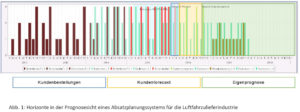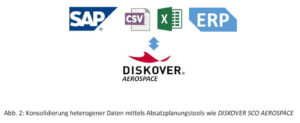Suppliers to the aerospace industry benefit from the advance orders placed by aircraft manufacturers and can plan their production at an early stage with the help of the demand forecasts and production plans (cadences) of the major manufacturers. What sounds like a blessing for many industries, however, presents aircraft manufacturers’ suppliers with the challenge of using the additional information correctly without getting bogged down in administrative work.
Due to the generally high level of complexity in the production and procurement of components in the aviation industry, the value creation processes often take a long time and are very demanding. In addition, the high cost pressure and limited capacities mean that customer orders should be produced as late as possible to avoid inventories, but as early as necessary to avoid overloading capacities. Reliable short-, medium- and long-term planning is therefore essential in order to achieve an optimal alignment of procurement and production.
In general, production and sales planning in the aviation industry can be divided into three time horizons (Fig. 1.). Current customer orders can be found in the near-term area. The subsequent period primarily contains the demand forecasts of the aircraft manufacturers, i.e. the customers (customer forecasts). As the customers’ demand forecasts in many supplier companies do not extend far enough into the future for corporate planning, procurement and production processes, it is necessary in these cases to fill the more distant planning horizon with the suppliers’ own forecasts (own forecasts) [KREHER 2018].
 Fig. 1: Overlapping planning horizons in the aerospace industry
Fig. 1: Overlapping planning horizons in the aerospace industry
The structure of the three forecast horizons differs depending on the customer. Some aircraft manufacturers provide their suppliers with a demand forecast in the form of CSV files via a dedicated supplier portal. Others, on the other hand, transfer planning data such as forecasts and orders in the form of Excel files that have to be imported into the ERP system. For most customers, the time series of orders and demand forecasts overlap; only a few synchronize them on a weekly basis. In addition to major customers such as Airbus and Boeing, it is above all the numerous small customers who increase the effort in the planning process; either due to a complete lack of a requirements forecast or due to different forms of provision of their requirements forecast, e.g. in Excel or as a PDF document. The provision of data via Excel and PDF also ensures a high potential for errors when manually transferring the data to your own planning system due to the media break.
In order to continuously improve data quality, some aircraft manufacturers have set up their own controlling system to determine the stability and accuracy of forecasts. The “accuracy” of a forecast indicates what proportion of the forecast quantity was actually realized as a customer order quantity in an analysis period. The “forecast stability” is used to measure the uniformity of all forecasts for a specific observation period. They are used to measure the fluctuations in the forecast values transmitted each week. However, many suppliers are faced with the challenge of calculating, evaluating and archiving these key figures for their large number of articles. The monitoring of these key figures, which can help to identify and complain about fluctuations that are not contractually agreed and which can ultimately even have legal significance, is almost impossible to manage without system support and requires a concept for the automated calculation and monitoring of the key figures.
At the end of the requirements forecast, the requirements forecast of some aircraft manufacturers “frays” for some parts. They then no longer fully reflect the expected quantities required and in some cases even have gaps.
Suppliers therefore usually also need their own demand forecasts that go beyond the customer’s demand forecast and fill in gaps. The so-called cadences, i.e. the aircraft manufacturers’ planning with regard to the expected monthly production figures for the individual aircraft models, can provide an initial good basis for planning. The cadences extend much further into the future than the requirements forecast provided by the customer.
If it is known which components are used in which aircraft models and in what quantities, these cadences can be used to create an initial forecast. Unfortunately, this “parts list factor” is not always fully known to the supplier companies. In addition, quite a few supplier parts are only optional parts that are not installed in every customer order for a specific aircraft model. In such cases, it is not enough to know the “BOM factor”; it is also necessary to calculate and use usage probabilities.
On closer inspection, the supposedly comfortable forecasting situation in the aviation industry turns out to be very challenging. The weal and woe of the supply industry depends on the quality of its own forecasts based on customers’ demand forecasts and cadences. Demand forecasts should therefore be mastered with corresponding precision. An organizationally and technically easy-to-handle solution is required here.
From coffee grounds reading to system-supported sales planning
What is required is a solution that links the customer’s sales forecasts with the company’s own forecasts and makes them manageable in their entirety before they flow into the ERP system.
Manual solutions using spreadsheets or inadequate analysis methods fall short. Even the most diligent sales planner would be completely overwhelmed by manually checking countless planned article figures every month. A random check carries the risk that not all errors in the forecast data are recognized and that errors are therefore passed on to procurement and production.
The introduction of specific sales planning tools, as shown in Fig. 2, the entire requirements planning process can be improved and carried out more efficiently.
 Fig. 2: Consolidation of heterogeneous data using sales planning tools such as DISKOVER SCO AEROSPACE [Kemmner 2018].
Fig. 2: Consolidation of heterogeneous data using sales planning tools such as DISKOVER SCO AEROSPACE [Kemmner 2018].
Key features of sales planning systems for the aviation supply industry
Continuous requirements plan, for each individual precast element, rolling over 24 or more months
All forecast information must be integrated into a consistent requirements plan and extended to the required planning horizon, but at least 24 months. Customer orders and forecasts must be compiled and supplemented with internal forecasts.
Merging all forecast information and formats
All data formats, including CSV data, Excel tables or PDFs, must be supported and displayed uniformly in one format. The standardization and automation of the recording and preparation of forecast data in the sales planning system and the associated elimination of media discontinuities leads to better and faster material number-specific planning.
Automatic determination of “self-forecasts”, partly with distribution-free methods
The system must independently determine forecast values for each material number beyond the period covered by the customer’s delivery schedules. The manufacturers’ cadence plans provide essential input for this; in some cases, time series must also be supplemented using statistical methods. Since many of the parts to be planned do not follow a normally distributed demand, distribution-free methods must be used [Kemmner 2018]
Statistical consideration of the probability of use
If the BOM factors between the aircraft and the delivered part are not known or if optional parts are involved, the sales planning system must statistically take into account the probabilities of use and continuously readjust using historical data. It is important that the probabilities are translated into concrete statements about the number of pieces; 65% of a part is never required, but always 100% or 0%.
![SCFA1803GER-Absatzprognose-Aerospace-final-003 | Abels & Kemmner - Supply chain optimisation Fig. 3: Example for the representation of the calculated usage probabilities of option parts [source: DISKOVER].](https://www.ak-online.de//wp-content/uploads/2019/03/SCFA1803GER-Absatzprognose-Aerospace-final-003-300x146.jpg) Fig. 3: Example of the representation of the calculated deployment probabilities of option parts [source: DISKOVER].
Fig. 3: Example of the representation of the calculated deployment probabilities of option parts [source: DISKOVER].
Largely automatic determination and adjustment of inconsistent time series
Gaps in customer forecasts, which experience has shown to occur towards the end of customers’ forecast horizons, must be automatically recognized and closed, or at least reported by alert reports.
Gross or net planning
It is important that the customer’s forecasts can be set as gross or net planning. The gross planning mechanism is used if the time series of the order dates and the requirements forecast of a customer overlap. The net planning status only shows data that is based solely on forecast data – i.e. data that has already been adjusted for customer orders.
Controlling forecast deviations
Finally, controlling functions for calculating and monitoring forecast accuracy and forecast stability are important. Sophisticated automated sales planning systems not only support the evaluation of past forecasts, but also use alert functions to provide early warnings if forecasts are missing or drop unexpectedly and cannot be repaired automatically (Fig. 4).
![SCFA1803GER-Absatzprognose-Aerospace-final-004 | Abels & Kemmner - Supply chain optimisation Fig. 4: Example of an evaluation of the forecast accuracy for the demand forecast of two customers [source: DISKOVER].](https://www.ak-online.de//wp-content/uploads/2019/03/SCFA1803GER-Absatzprognose-Aerospace-final-004-300x177.jpg) Fig. 4: Example of an evaluation of the forecast accuracy for the demand forecast of two customers [source: DISKOVER].
Fig. 4: Example of an evaluation of the forecast accuracy for the demand forecast of two customers [source: DISKOVER].
Planned requirements offset according to delivery plant
The requirement dates provided by the customers usually correspond to the delivery dates at the plant to which delivery is to be made and not the date on which a part is ready for dispatch from the supplier. Depending on the distance and transportation costs, there may be considerable time between the two appointments. Efficient sales planning systems can take this planned requirements offset into account
Maintenance of follow-up material, expiry date and sales start date
Predecessor-successor relationships as well as the expiry date and sales start date are important parameters for presenting the planning situation as completely as possible and providing comprehensive results.
Ongoing data synchronization with the ERP system
The sales planning system must exchange data with the ERP system on a daily basis in order to synchronize the demand forecast and customer orders.
Data pre- and post-processing between ERP system and sales planning system
The challenges of data preparation in sales planning in the aviation supply sector are difficult to solve within the rigid structure of ERP systems. Data from the ERP systems often has to be processed and corrected in order to compensate for inconsistencies due to a lack of data maintenance in the ERP system. This is considerably easier and more flexible when using separate systems and databases. When restoring the data, it may also be necessary to merge planned values, which may have been determined in a more differentiated way, before they are transferred to the ERP system.
Practical experience has shown that the use of ERP-linked sales planning systems for the aerospace industry can massively reduce planning costs. The focus of sales planners’ work is shifting from the extensive, laborious and error-prone manual preparation of series of figures to their intelligent interpretation.
To paraphrase a well-known bon mot by Mark Twain, we can therefore conclude: “Forecasts are not always a difficult thing, even when they concern the future”. But without a systematic approach and automated processes, demand planning is little different from reading coffee grounds.
Bibliography (in alphabetical order)
Kemmner, A.: Getting a grip on inventories and delivery readiness (Part 1.), in: Productivity Management, 2010, H. 2, pp. 29-31
Kemmner, A.: Getting a grip on inventories and delivery readiness (Part 2.), in: Productivity Management, 2010, H. 3, pp. 54-56
Kemmner, A.: Better to make a precise error than a chance hit, in: Productivity Management, 2014, H. 4, p. 32
Kemmner, A.: Best practice rules for efficient sales forecasting
https://www.ak-online.de/fachartikel/absatzprognose/
Kreher, E., Franken, T., Peressini, M.-C.: System-supported sales planning, in: IT & Production, 2018, H4, pp. 50-51

